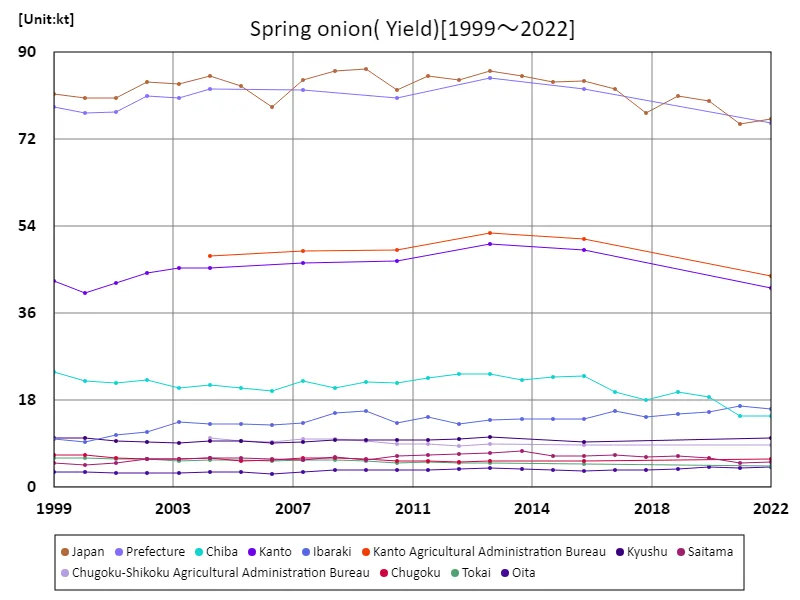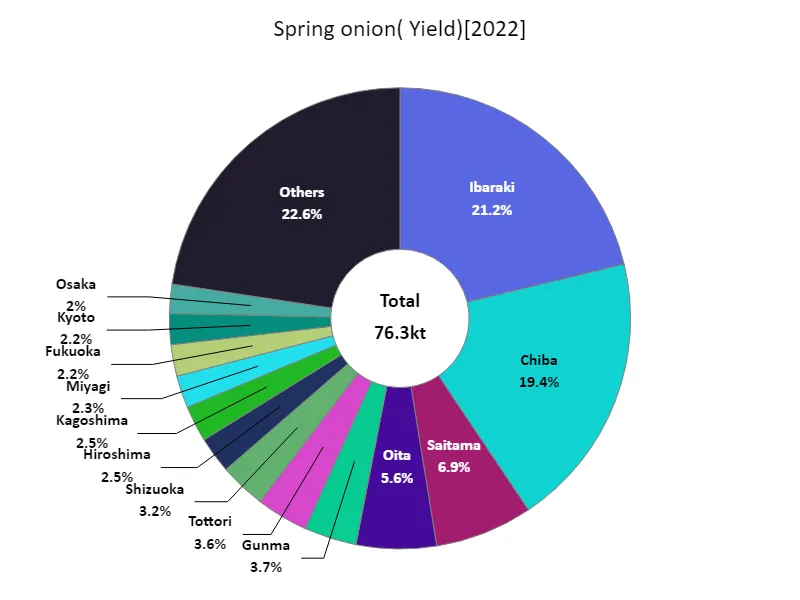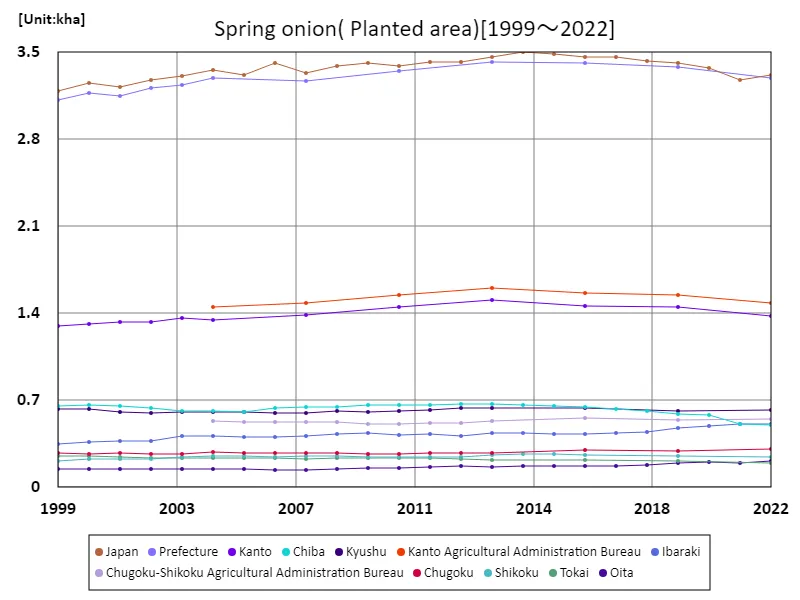Abstract
Looking at data on leafy vegetables in Japanese agriculture, especially spring onions, the harvest volume nationwide in 2022 will be 76.3kt, with the maximum cultivated area being 3.32kha, and the maximum shipping volume being 15.2kt in Ibaraki. The trends and characteristics that can be inferred from these figures are that, first, the relatively large nationwide harvest volume indicates that spring onion production is widespread. This is supported by the maximum cultivated area, suggesting that spring onions are cultivated over a wide area. On the other hand, since the highest shipping volume was in Ibaraki, it is highly likely that certain regions are major producers of spring onions. These data show that spring onions are an important leafy vegetable in Japanese agriculture, and although they are widely produced throughout the country, they are cultivated and shipped more actively in certain regions, such as Ibaraki.
Spring onion harvest yield (main data).
In Japanese agriculture, spring onion harvest volumes have fluctuated between 1999 and 2022. In 2009, the national harvest reached a peak of 86.6kt. However, yields have declined in the following years and have now settled at a level that is just 88.1% of the peak. This trend suggests that spring onion production is declining slightly from its peak. This may be due to a variety of factors, including changes in the agricultural environment and demand, as well as technological advances. Also, since peak yields were recorded in 2009, there may be a move towards more sustainable levels of spring onion production.


The maximum is 86.6kt[2009] of Japan, and the current value is about 88.1%
Spring onion harvest volume (by prefecture).
Looking at the harvest volume of leafy vegetables in Japanese agriculture, data for 2022 shows that Ibaraki recorded the highest yield overall at 16.2kt. This is the highest figure ever recorded and demonstrates Ibaraki’s leading role in leafy vegetable production. Ibaraki’s geographical conditions and advances in agricultural technology may be supporting the region’s production volume. On the other hand, while harvest yields in other regions may also be increasing relatively, it appears that Ibaraki still occupies the top position. As demand for leafy vegetables is increasing, we may see an expansion in production in each region. In general, Japan’s leafy vegetable farming is centered in Ibaraki, and production volumes appear to be on the rise.


The maximum is 16.2kt of Ibaraki, the average is 1.62kt, and the total is 76.3kt
Area planted with spring onions (main data).
In Japanese agriculture, the area planted with spring onions has fluctuated from 1999 to 2022. The peak was recorded in 2014 at 3.5kha nationwide, but it has now settled at a level equivalent to 94.9% of that. This trend shows that it has decreased slightly from its peak. There are many factors that will affect the area planted with spring onions, but possible factors include changes in demand, agricultural policy influences, or conversion to other crops. On the other hand, as demand for spring onions remains relatively high compared to peak levels, it is believed that they occupy an important position in agricultural production, with demand for them remaining strong. The area planted with spring onions may fluctuate in the future due to changes in demand and technological innovations in agriculture, but its importance is expected to continue.


The maximum is 3.5kha[2014] of Japan, and the current value is about 94.9%
Spring onion cultivation area (by prefecture).
Looking at the area of land cultivated with leafy vegetables in Japanese agriculture, data from 2022 shows that Ibaraki has the largest area cultivated with 508 hectares. This is the highest figure ever recorded and demonstrates Ibaraki’s leading role in leafy vegetable production. Ibaraki’s geographical conditions and advances in agricultural technology may be supporting the area cultivated in this region. On the other hand, it is possible that the cultivated area in other regions is also increasing relatively, but it appears that Ibaraki still occupies the top position. As demand for leafy vegetables is increasing, we may see an increase in the area planted in each region. In general, leafy vegetable farming in Japan is centered in Ibaraki, and the area cultivated appears to be on the rise.


The maximum is 508ha of Ibaraki, the average is 70.7ha, and the total is 3.32kha
Shipping volume of spring onions.
Looking at data for 2022 on the shipping volume of spring onions, a type of leafy vegetable in Japanese agriculture, Ibaraki recorded the highest volume overall at 15.2kt. And the average shipping volume is 1.45kt, with the total being 68.1kt. The characteristics and trends that can be seen from these figures first show that Ibaraki is a major shipping area for spring onions. Ibaraki’s geographical conditions and advances in agricultural technology may support the production and shipping of spring onions in the region. On the other hand, the overall average shipping volume was 1.45kt, suggesting that demand for spring onions is relatively stable. This suggests that farmers and producers are shipping the right amount at the right time. In general, spring onion shipments are centered in Ibaraki, and demand and supply appear to be relatively stable.


The maximum is 15.2kt of Ibaraki, the average is 1.45kt, and the total is 68.1kt



Comments